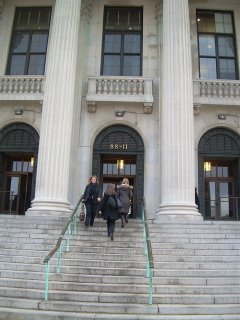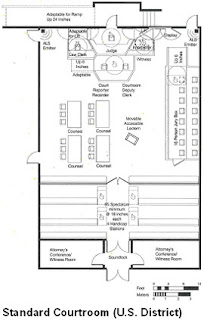For once, I am a spectator in the courtroom. My “partner[1]” is in chambers with the Judge and three defense lawyers having a customary discussion about the case which has just been assigned to the Judge for a trial in which the jury has already been selected and opening statements are about to be given.
I am seated in the front row of the spectator section when the attorneys and Judge enter the courtroom in noisy haste. The Judge ascends the bench and orders the court officer to bring in the Jury. Once they are seated he directs my partner to proceed with his opening statement, omitting the preliminary jury instructions which are customary.
After he is finished, the defense attorneys each give opening statements in turn.
Only then is a break taken, and I learn from my partner that the Judge has taken great offense at something he said while they were in chambers.
The first witness was a defendant physician. Defense counsel objects to almost every question asked and the Judge sustains each and every one without permitting any arguments. The attorneys are seated at counsel tables in the well of the courtroom, the plaintiff’s attorney at one table alone, nearer the jury, and all three defense lawyers at another table adjacent to plaintiff and further away from the jury almost on the opposite side of the courtroom.
The witness stand is closer to the jury on the Judge’s left side.
Each time the doctor’s attorney makes an objection, he rises without speaking. When the question has been completely articulated, the witness awaits the Judge’s ruling before speaking, which ultimately proves to be unnecessary in any event. Finally, after a brief and urgent whispered conversation with me, my partner begins to use the defendant’s deposition to question him, a tactic that met with better success than the simple questioning which had preceded it.
The tenor of the trial has been established, although I cannot imagine what has been said to cause such offense.
Now, our client is on the stand. He is blind in his right eye, a fact which is not in dispute – the eye had been surgically removed.
As my partner is questioning him, the defense attorney rises wordlessly to make an objection. The plaintiff answers the question. Defense counsel begins shouting; “Objection! Objection! He is answering even though I objected to the question.”
The plaintiff turns his head to his right and says “I’m sorry Mr. [defense attorney], I didn’t see you. You were standing on my blind side.”
A tremendous storm of objections ensues, leading the Judge to excuse the jury from the courtroom. Arguments are made back and forth at great length.
The resolution ordered by the Judge over the objection of the Mr. [plaintiff’s attorney] is that each member of the jury will ascend the witness stand in turn and cover their right eye. Mr. [defense attorney] will rise as if making an objection, and in this manner, each of the jurors will be able to assess whether the plaintiff had been truthful in asserting that he had not seen the defense attorney.
And so, in turn, each juror sat in the witness box covering their right eye while Mr. [defense attorney] stood. Each juror, with the eye covered, turned their head to see Mr. [defense attorney].
Do you really need me to tell you what the jury verdict was?
My partner was furious! He was determined to appeal the verdict in the name of PRINCIPLE. The decision to appeal was one I did not agree with for many reasons, although I did believe we would be granted a new trial.
When a party appeals a jury verdict, the entire transcript of the trial made by the court reporter (stenographer) is assembled for the benefit of the reviewing court and the parties write legal briefs summarizing the facts and discussing the legal case law that should be applied to those facts to bring about a desired resolution of the issues raised by the appeal.
In reading the record I was able to see what had transpired in chambers before they all appeared in the courtroom. Mr. [defense attorney] made a motion in limine which means to limit the proof in regard to some issue. Mr. [plaintiff attorney] objected. The Judge began to explain that the rule against hearsay is based upon the constitutional right to confront one’s accuser.
Mr. [plaintiff attorney] began to lecture the Judge that the hearsay rule predated the constitution by hundreds of years and came to this country in the Magna Carta. Reading that transcript, one can almost see smoke coming out of the Judge’s ears as he instructed Mr. [plaintiff attorney] to “get out of my chambers!”
The attorney appeared not to realize that he had caused offense, and continued trying to discuss the issue with the Judge. The Judge then began calling for the “Marshalls”. There are no Marshalls in state court, they are called court officers. He apparently meant to have him physically removed if he would not go voluntarily.
I learned after our “partnership” ended (within months after that trial) that a new trial had been granted by the appellate court. A new jury had reached the same result, at a probable cost of at least an additional $30,000.00 to plaintiff.
It gave new meaning to the term Pyrrhic victory and gave me a new perspective on what it means to defend “principle.”
[1] From September 1994 until February 1996 I was a nominal partner in a law firm (the partnership agreement was never signed by my older and more experienced “partner” who was also the senior partner in a defense firm).




